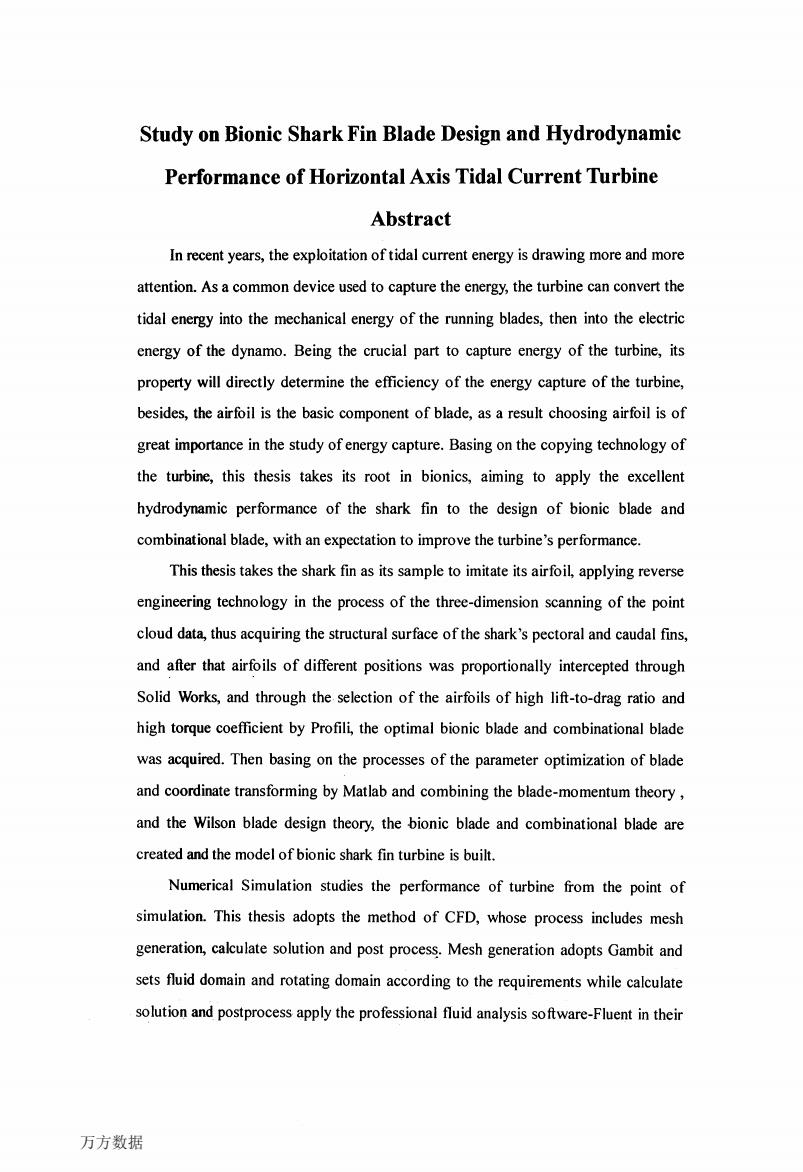
Study on Bionic Shark Fin Blade Design and Hydrodynamic Performance of Horizontal Axis Tidal Current Turbine Abstract In recent years,the exploitation of tidal current energy is drawing more and more attention.As a common device used to capture the energy,the turbine can convert the tidal energy into the mechanical energy of the running blades,then into the electric energy of the dynamo.Being the crucial part to capture energy of the turbine,its property will directly determine the efficiency of the energy capture of the turbine, besides,the airfoil is the basic component of blade,as a result choosing airfoil is of great importance in the study of energy capture.Basing on the copying technology of the turbine,this thesis takes its root in bionics,aiming to apply the excellent hydrodynamic performance of the shark fin to the design of bionic blade and combinational blade,with an expectation to improve the turbine's performance. This thesis takes the shark fin as its sample to imitate its airfoil,applying reverse engineering technology in the process of the three-dimension scanning of the point cloud data,thus acquiring the structural surface of the shark's pectoral and caudal fins, and after that airfoils of different positions was proportionally intercepted through Solid Works,and through the selection of the airfoils of high lift-to-drag ratio and high torque coefficient by Profili,the optimal bionic blade and combinational blade was acquired.Then basing on the processes of the parameter optimization of blade and coordinate transforming by Matlab and combining the blade-momentum theory, and the Wilson blade design theory,the bionic blade and combinational blade are created and the model of bionic shark fin turbine is built. Numerical Simulation studies the performance of turbine from the point of simulation.This thesis adopts the method of CFD,whose process includes mesh generation,calculate solution and post process.Mesh generation adopts Gambit and sets fluid domain and rotating domain according to the requirements while calculate solution and postprocess apply the professional fluid analysis software-Fluent in their 万方数据
Study on Bionic Shark Fin Blade Design and Hydrodynamic Performance of Horizontal Axis Tidal Current Turbine Abstract In recent years,the exploitation oftidal current energy is drawing more and more attention.As a common device used to capture the energy,the turbine can convert the tidal energy into the mechanical energy of the running blades,then into the electric energy of the dynamo.Being the crucial part to capture energy of the turbine,its property will directly determine the efficiency of the energy capture of the turbine, besides,the airfoil is the basic component of blade,as a result choosing airfoil is of great importance in the study of energy capture.Basing on the copying technology of the turbine,this thesis takes its root in bionics,aiming to apply the excellent hydrodynamic performance of the shark fin to the design of bionic blade and combinational blade,with an expectation to improve the turbine’S performance. This thesis takes the shark fin as its sample to imitate its airfoil,applying reverse engineering techno logy in the process of the three-dimension scanning of the point cloud data,thus acquiring the structural surface of the shark’S pectoral and caudal fms, and after that airfoils of different positions was proportionally intercepted through Solid Works,and through the selection of the airfoils of high lift-to-drag ratio and high torque coefficient by Profili,the optimal bionic blade and combinational blade was acquired.Then basing on the processes of the parameter optimization of blade and coordinate transforming by Matlab and combining the blade-momentum theory, and the Wilson blade design theory,the bionic blade and combinational blade are created and the model of bionic shark fin turbine iS built. Numerical Simulation studies the performance of turbine from the point of simulation.This thesis adopts the method of CFD,whose process includes mesh generation,calculate solution and post process.Mesh generation adopts Gambit and sets fluid domain and rotating domain according to the requirements while calculate solution and postprocess apply the professional fluid analysis software.Fluent in their 万方数据
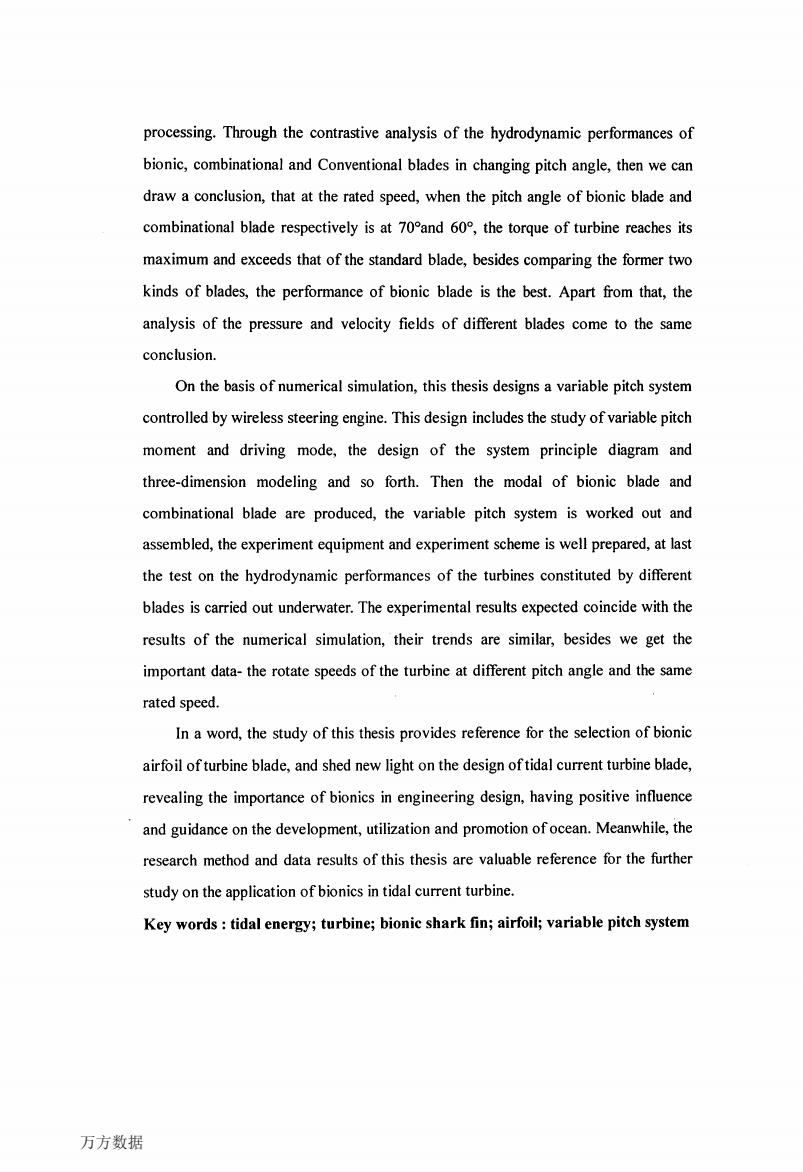
processing.Through the contrastive analysis of the hydrodynamic performances of bionic,combinational and Conventional blades in changing pitch angle,then we can draw a conclusion,that at the rated speed,when the pitch angle of bionic blade and combinational blade respectively is at 70and 60,the torque of turbine reaches its maximum and exceeds that of the standard blade,besides comparing the former two kinds of blades,the performance of bionic blade is the best.Apart from that,the analysis of the pressure and velocity fields of different blades come to the same conclusion. On the basis of numerical simulation,this thesis designs a variable pitch system controlled by wireless steering engine.This design includes the study of variable pitch moment and driving mode,the design of the system principle diagram and three-dimension modeling and so forth.Then the modal of bionic blade and combinational blade are produced,the variable pitch system is worked out and assembled,the experiment equipment and experiment scheme is well prepared,at last the test on the hydrodynamic performances of the turbines constituted by different blades is carried out underwater.The experimental results expected coincide with the results of the numerical simulation,their trends are similar,besides we get the important data-the rotate speeds of the turbine at different pitch angle and the same rated speed. In a word,the study of this thesis provides reference for the selection of bionic airfoil of turbine blade,and shed new light on the design of tidal current turbine blade, revealing the importance of bionics in engineering design,having positive influence and guidance on the development,utilization and promotion of ocean.Meanwhile,the research method and data results of this thesis are valuable reference for the further study on the application of bionics in tidal current turbine. Key words tidal energy;turbine;bionic shark fin;airfoil;variable pitch system 万方数据
processing.Through the contrastive analysis of the hydrodynamic performances of bionic,combinational and Conventional blades in changing pitch angle,then we can draw a conclusion,that at the rated speed,when the pitch angle of bionic blade and combinational blade respectively is at 700and 600.the torque of turbine reaches its maximum and exceeds that of the standard blade,besides comparing the former two kinds of blades,the performance of bionic blade is the best.Apart from that,the analysis of the pressure and velocity fields of different blades come to the same conclusion. On the basis of numerical simulation,this thesis designs a variable pitch system controlled by wireless steering engine.This design includes the study of variable pitch moment and driving mode,the design of the system principle diagram and three-dimension modeling and SO forth.Then the modal of bionic blade and combinational blade are produced,the variable pitch system is worked out and assembled,the experiment equipment and experiment scheme is well prepared,at last the test on the hydrodynamic performances of the turbines constituted by different blades is carried out underwater.The experimental results expected coincide with the results of the numerical simulation,their trends are similar,besides we get the important data-the rotate speeds of the turbine at different pitch angle and the same rated speed. In a word,the study of this thesis provides reference for the selection of bionic airfoil ofturbine blade,and shed new light on the design oftidal current turbine blade, reveal ing the importance of bionics in engineering design,having positive influence and guidance on the development,utilization and promotion ofocean.Meanwhile,the research method and data results of this thesis are valuable re诧rence for the further study on the application of bionics in tidal current turbine. Key words:tidal energy;turbine;bionic shark fin;airfoil;variable pitch system 万方数据
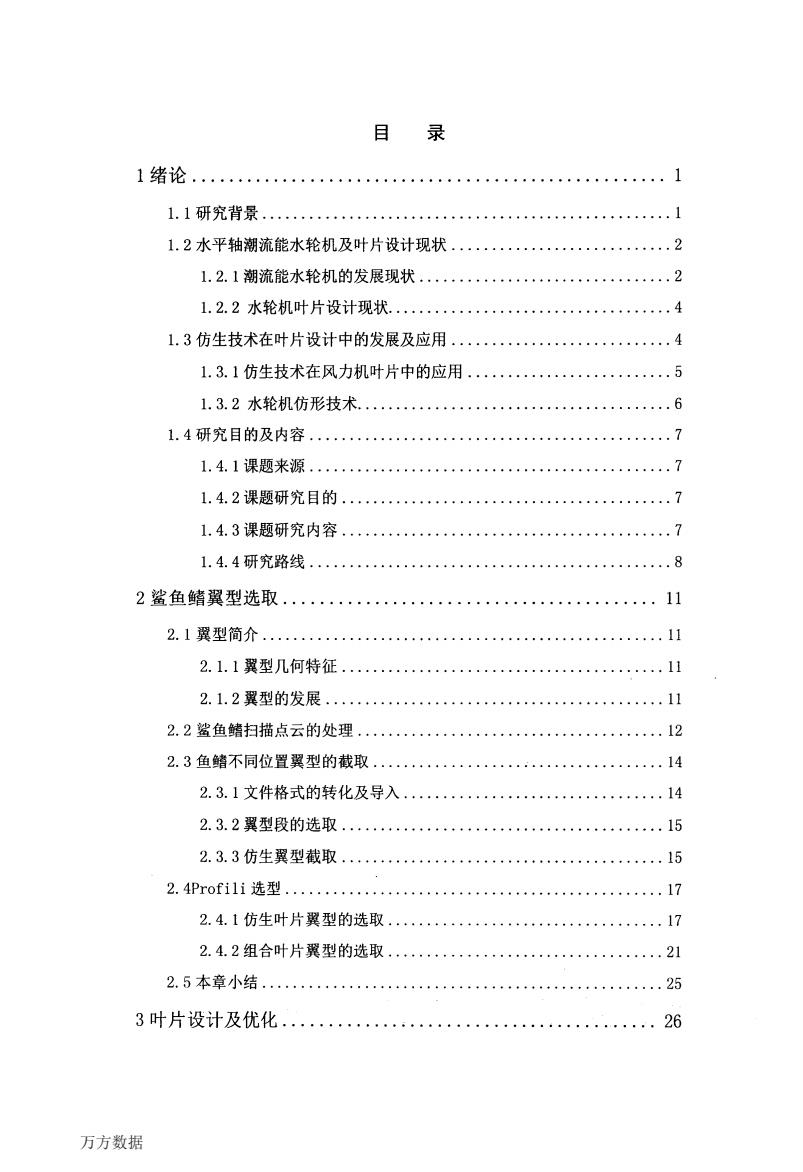
目 录 1绪论..… 1.1研究背景.… 1.2水平轴潮流能水轮机及叶片设计现状.. 2 1.2.1潮流能水轮机的发展现状.......2 1.2.2水轮机叶片设计现状..... 1.3仿生技术在叶片设计中的发展及应用........4 1.3.1仿生技术在风力机叶片中的应用........5 1.3.2水轮机仿形技术. ……6 1.4研究目的及内容 ….7 1.4.1课题来源.. ….7 1.4.2课题研究目的 .7 1.4.3课题研究内容.…. .7 1.4.4研究路线.. 2鲨鱼鳍翼型选取..·. 11 2.1翼型简介...… …11 2.1.1翼型几何特征..... 2.1.2翼型的发展. …………11 2.2鲨鱼鳍扫描点云的处理... 12 2.3鱼鳍不同位置翼型的截取.. ……14 2.3.1文件格式的转化及导入 ….14 2.3.2翼型段的选取.. ..15 2.3.3仿生翼型截取.... 15 2.4 Profi1i选型...… > 2.4.1仿生叶片翼型的选取 ,17 2.4.2组合叶片翼型的选取 …21 2.5本章小结.. 25 3叶片设计及优化... 26 万方数据
目 录 1绪论…………….………………………………1 1.1研究背景…………………………………………….1 1.2水平轴潮流能水轮机及叶片设计现状……………………….2 1.2.1潮流能水轮机的发展现状…………………………..2 1.2.2水轮机叶片设计现状………………………………4 1.3仿生技术在叶片设计中的发展及应用……………………….4 1.3.1仿生技术在风力机叶片中的应用……………………..5 1.3.2水轮机仿形技术………………………………….6 1.4研究目的及内容……………………………………….7 1.4.1课题来源….……………………………………7 1.4.2课题研究目的……………………………………7 1.4.3课题研究内容…………….………………..……7 1.4.4研究路线….……………………………………8 2鲨鱼鳍翼型选取…………………………………..11 2.1翼型简介……….………….…....…………………ll 2.1.1翼型几何特征…………………………………..11 2.1.2翼型的发展…………………………………….11 2.2鲨鱼鳍扫描点云的处理……….......…………………..12 2.3鱼鳍不同位置翼型的截取……….……….……………..14 2.3.1文件格式的转化及导入……….…………………..14 2.3.2翼型段的选取…………………………………..15 2.3.3仿生翼型截取…………………………………..15 2.4Profili选型……………….……………….…...….17 2.4.1仿生叶片翼型的选取………....……………..…..17 2.4.2组合叶片翼型的选取………..…………….……..21 2.5本章小结……………………………………………25 3叶片设计及优化..….………………………..…….26 万方数据
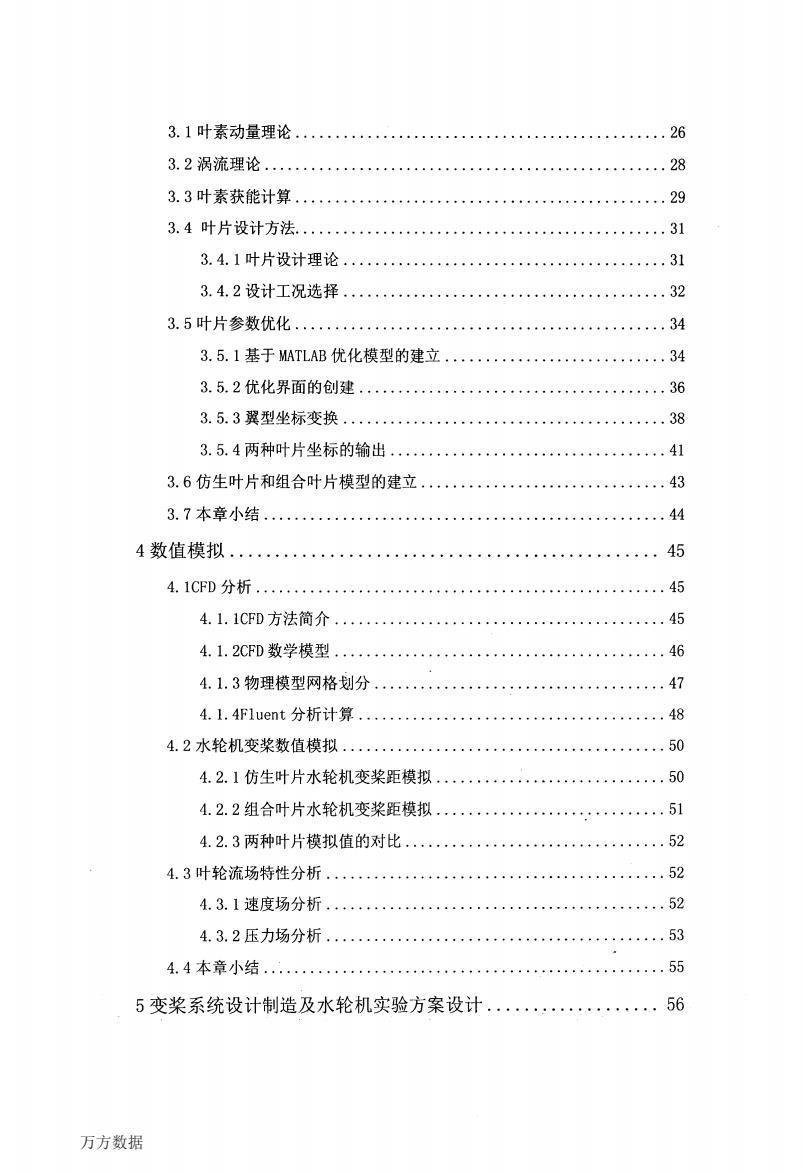
3.1叶素动量理论.… ….26 3.2涡流理论 .28 3.3叶素获能计算 .29 3.4叶片设计方法... 31 3.4.1叶片设计理论..31 3.4.2设计工况选择..... .32 3.5叶片参数优化...… …………34 3.5.1基于MATLAB优化模型的建立... .34 3.5.2优化界面的创建..... ………36 3.5.3翼型坐标变换...... 38 3.5.4两种叶片坐标的输出… 41 3.6仿生叶片和组合叶片模型的建立 43 3.7本章小结.. 44 4数值模拟... 45 4.1CPD分析 .45 4.1.1CFD方法简介..... 45 4.1.2CD数学模型.… 46 4.1.3物理模型网格划分 47 4.1.4F1uet分析计算,.,...48 4.2水轮机变桨数值模拟....... 50 4.2.1仿生叶片水轮机变桨距模拟.. .50 4.2.2组合叶片水轮机变桨距模拟. ..51 4.2.3两种叶片模拟值的对比..52 4.3叶轮流场特性分析., ......52 4.3.1速度场分析.. .52 4.3.2压力场分析.· .53 4.4本章小结. ,55 5变桨系统设计制造及水轮机实验方案设计...·56 万方数据
3.1叶素动量理论………………………………………..26 3.2涡流理论……..…………………………………….28 3.3叶素获能计算………………………………………..29 3.4叶片设计方法……………………….……………….31 3.4.1叶片设计理论…………………………………..3l 3.4.2设计工况选择…………………………………..32 3.5叶片参数优化…..……………………………………34 3.5.1基于MATLAB优化模型的建立……………………….34 3.5.2优化界面的创建…………………………………36 3.5.3翼型坐标变换…………………………………..38 3.5.4两种叶片坐标的输出……………………………..41 3.6仿生叶片和组合叶片模型的建立………………………….43 3.7本章小结……………………………………………44 4数值模拟………………………………………..45 4.1CFD分析…………………………………………….45 4.1.1CFD方法简介…………….……..………….…..45 4.1.2CFD数学模型……………………………………46 4.1.3物理模型网格划分…………………………….…47 4.1.4Fluent分析计算.………………………......…..48 4.2水轮机变桨数值模拟…………………………………..50 4.2.1仿生叶片水轮机变桨距模拟………..………………50 4.2.2组合叶片水轮机变桨距模拟………………………..51 4.2.3两种叶片模拟值的对比………………………......52 4.3叶轮流场特性分析…………………………………….52 4.3.1速度场分析....……………….………………..52 4.3.2压力场分析.………………………….…..……53 4.4本章小结……..….………...……………..……….55 5变桨系统设计制造及水轮机实验方案设计………一…..一.56 万方数据
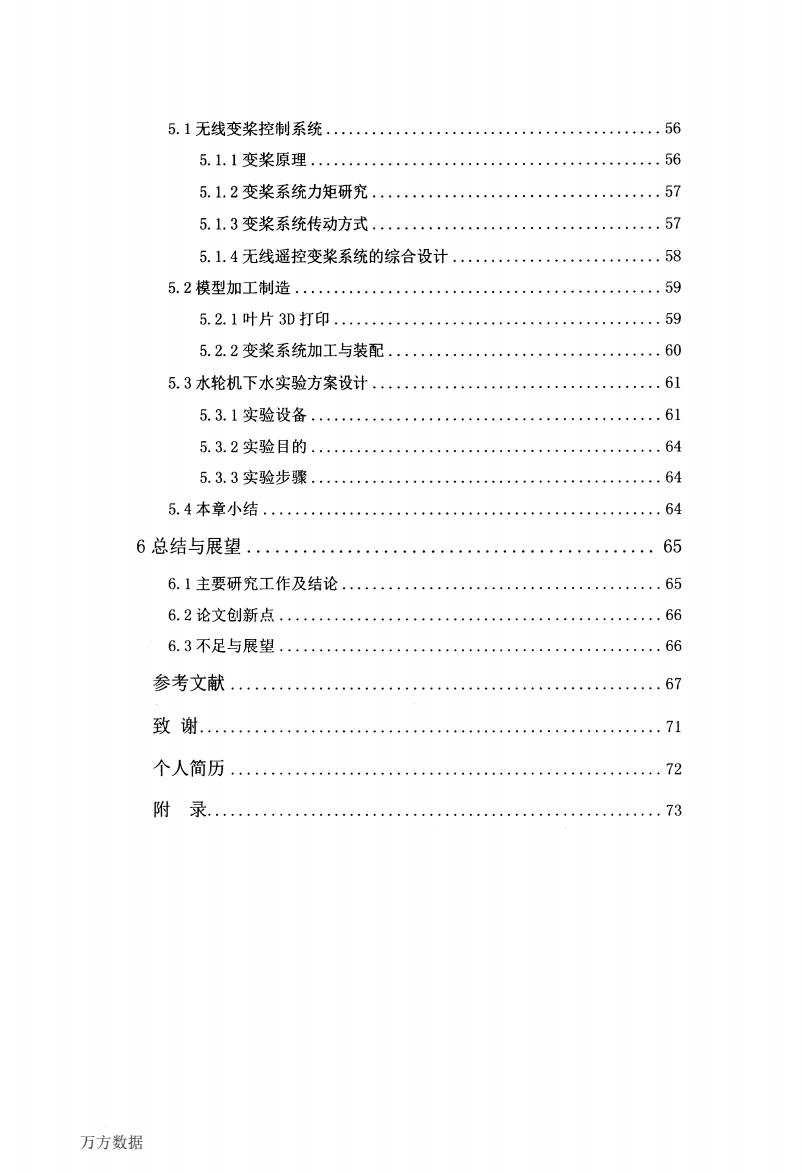
5.1无线变桨控制系统..56 5.1.1变桨原理.........56 5.1.2变桨系统力矩研究..57 5.1.3变桨系统传动方式… .57 5.1.4无线遥控变桨系统的综合设计......58 5.2模型加工制造.....… .59 5.2.1叶片3D打印.. 59 5.2.2变桨系统加工与装配 60 5.3水轮机下水实验方案设计 .61 5.3.1实验设备… .61 5.3.2实验目的... .64 5.3.3实验步骤. .64 5.4本章小结.…… 64 6总结与展望…… 65 6.1主要研究工作及结论 .65 6.2论文创新点 .66 6.3不足与展望. *66 参考文献 致谢.… .71 个人简历 ..72 附录. ,73 万方数据
5.1无线变桨控制系统…………………………………….56 5.1.1变桨原理………………………………………56 5.1.2变桨系统力矩研究……………………………….57 5.1.3变桨系统传动方式……………………………….57 5.1.4无线遥控变桨系统的综合设计………………………58 5.2模型加工制造………………………………………..59 5.2.1叶片3D打印……………………………………59 5.2.2变桨系统加工与装配……………………………..60 5.3水轮机下水实验方案设计……………………………….6l 5.3.1实验设备………………………………………61 5.3.2实验目的………………………………………64 5.3.3实验步骤………….…………………………..64 5.4本章小结……………………………………………64 6总结与展望………………………………………65 6.1主要研究工作及结论…………………………………..65 6.2论文创新点…………………………….……………66 6.3不足与展望…………………………….……………66 参考文献……………………………………………….67 致谢…………………………………………………..71 个人简历……………………………………………….72 附录………………………………………………….73 万方数据